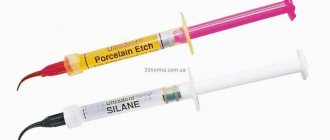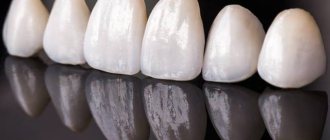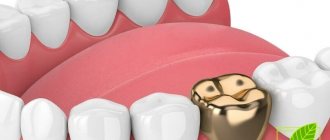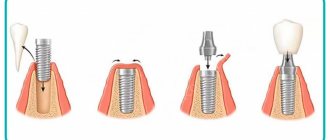A bridge on implants is a reasonable prosthetic option for the loss of 3 teeth to their complete absence . Cheaper than implantation of each lost tooth, more reliable than bridge prosthetics on your own teeth.
In our Center they are installed after computer diagnostics and bite examination, and are manufactured in our own dental laboratory. A lifetime warranty is provided for implants in our Center, and 25 years for metal-free crowns as part of a bridge.
A dental bridge on implants is a non-removable orthopedic structure made from welded crowns to restore several teeth in a row.
- Difference from traditional bridges The bridge is supported not by your own teeth, but by pre-installed implants. There is no need to grind down the enamel of adjacent healthy teeth.
- Difference from classical implantation Each tooth does not require a separate implant; fewer are installed. And the bridge includes crowns for each tooth. Allows you to save money.
Bridge prosthesis on implants
Advantages
If you lose several teeth in a row, dental bridges on implants are the right solution. Allows you to correctly distribute the load and not use healthy teeth.
- Neighboring teeth do not deteriorate. The supports are implants implanted into the jaw, and not your own teeth, which must be ground down.
- Durability Implants last a lifetime, and the service life of the prosthesis is at least twice as long as that of classic bridges.
- Aesthetics Crowns are no different from your own teeth. The aesthetic gingival contour is recreated.
- Affordability Savings compared to classic implantation, when each tooth is replaced with an implant and a crown.
Contraindications to the installation of metal ceramics
If you need to replace teeth, metal ceramics are an excellent option for dentures. It has been mentioned more than once about the aesthetics and anatomical accuracy of this material, as well as the natural shine and shade of crowns and dentures, which creates an absolute resemblance to a natural tooth. However, it is not always possible to use metal ceramics. In case of periodontal and chewing muscle diseases, malocclusion, pathological abrasion of dental tissue, as well as for children and adolescents, this type of prosthetics is undesirable.
Is it always possible to put a bridge on implants?
A bridge prosthesis on implants is suitable in any clinical situation, regardless of the extent and location of the defect in the jaw
Installed when:
- loss of three adjacent teeth in a row; with fewer teeth there is no need
- absence of outer teeth in a row , when there is no support on one side for a conventional bridge
- complete edentia , when there are absolutely no supports for fixation for a traditional bridge
Bridges on implants do not require grinding of adjacent teeth.
They are used even in cases of terminal defects and complete edentia, which cannot be achieved with traditional bridge prosthetics. Another undoubted advantage is that there is no need to prepare the enamel of neighboring teeth, which means they will remain healthy and last longer.
Levin Dmitry Valerievich Chief physician and founder of the Doctor Levin center
Disadvantages of metal-ceramic dental bridges
The design is very popular as it allows you to restore teeth quickly and easily. However, the method is not without drawbacks, including:
PROMOTION
Metal-ceramic crowns and bridges
3450 rub.
- Incorrect distribution of chewing load. A dental bridge allows you to restore only the upper part of the tooth, that is, its crown. The place where the root should be placed remains empty and does not receive stress during chewing. Bone resorption continues, and over time, supporting teeth may lose stability.
- Damage to supporting teeth. A metal-ceramic crown can only be installed on a ground tooth from which the nerve has been removed. A pulpless tooth instantly loses ten years of life, as its nutrition stops. If the supporting teeth have already undergone dental treatment and their nerves have been removed, the problem does not seem so critical. If they are absolutely healthy, it is worth considering other methods of prosthetics, including considering the option of installing an implant.
- Loss of structural strength over time. Normally, teeth have some mobility. When a bridge is installed, it very firmly fixes them, connecting them together. Due to this, the natural state of the dentition is disrupted and this can, over time, lead to a loss of strength of the installed prosthesis.
- A metal-ceramic bridge may cause allergies in patients who react to metal. A dark stripe may also appear on the gum, which occurs due to metal oxidation.
- The metal can show through the ceramic layer; the teeth do not look completely natural. This is only important for the front part of the dentition. Due to the fact that the core of the bridge is metal, artificial teeth do not have the required transparency.
- Aesthetic indicators impose restrictions on use in the smile area. If financial capabilities allow, it is better to choose a bridge prosthesis based on zirconium dioxide or a ceramic version without metal for this area.
How many implants are needed for partially missing teeth?
When calculating the number of implants, we take into account the distribution of chewing load
The load on the jaw when chewing should be uniform so that there is no subsidence of the gums and bone tissue under the hinged crowns. This will ensure the durability of the prosthesis and maintain aesthetics. Therefore, fixing a bridge on 2 implants is not always the right solution. It is recommended to use a 1:2 calculation - one implant for 2 crowns . Accordingly, the more teeth are missing, the more implants will be needed.
1-2 teeth missing
In this situation, bridges supported by implants are not relevant; teeth are restored separately. Each one has its own implant, which is covered with a separate crown. In this case, it is not recommended to combine crowns - if one is damaged, you will have to remove two at once. No 3 teeth
The most common clinical picture.
If there are no three adjacent teeth in a row, 2 implants are implanted along the edges of the defect, and a prosthesis for 3 teeth in the form of interconnected crowns is fixed on them. The outer ones are mounted on supports, and the middle one is hinged. You can install three implants, but this solution is cheaper. 4 missing teeth
When installing a bridge on 4 missing teeth in a row, the number of supports increases to three, and the number of crowns increases to four.
If you use two supports, then there will also be two mounted crowns. Atrophy of the jaw bone under the prosthesis cannot be ruled out due to uneven load. And the risk of prosthesis breakage increases due to increased pressure on the central part. No 5 teeth
Bridge prosthetics on implants is possible for 5 teeth or more. If five teeth are missing, three implants are needed. If a bridge of 6 teeth or more is required, three supports are used - the number is calculated by the number of crowns in the structure. The degree of future load and its distribution on the bone tissue are taken into account to prevent atrophy.
Comparison of methods by characteristics
Prosthetics on implants and a bridge have a number of fundamental differences. Each technique has advantages and disadvantages. The doctor chooses the technology after assessing all factors.
Advantages
Implants are able to withstand increased chewing loads, distributing them evenly across the jaw, due to this they are not destroyed during operation. Unlike classic bridges on your teeth, which require systematic re-cementing, implants are implanted once and for life.
In the case of classic bridges, the load falls on the supporting teeth. This can lead to their gradual destruction and removal. The size of the prosthesis will increase until there are no units left to act as support. At the site of the defect, bone tissue atrophy will continue. Implantation solves this problem.
Flaws
The main disadvantages of implantation include:
- high cost - but considering that implants are installed for life, the costs are justified;
- many contraindications - currently the list of contraindications has decreased, new technologies have been developed;
- treatment period (if a two-stage protocol with delayed loading is used, accompanied by osteoplastic intervention) - one-stage technologies will allow you to restore the dentition in 1-3 days.
Installation of a bridge requires the preparation of two supports. It’s sad if you have to injure healthy units. Due to the uneven redistribution of mechanical load, bone tissue atrophy accelerates, the contour of the gum changes and sags. A gap appears between the bridge and the gum where bacterial plaque and food particles accumulate. Not all prosthetic structures are subject to repair and relocation. Teeth under crowns are subject to secondary caries, which will lead to rapid tissue destruction and an increase in the length of the defect.
Contraindications
Implantation is a surgical procedure with some contraindications. But unlike the classic bridge, a number of protocols can be used for serious periodontal pathologies, problems with bite, occlusion, and a complicated medical history.
Both methods are contraindicated in:
- inflammatory process of the oral cavity;
- infections in the acute stage;
- chronic diseases in the stage of decompensation.
Absolute contraindications to implantation include oncology and severe bleeding disorders. A bridge is not installed in cases of terminal and long-term defects (loss of 4 units in a row or more), malocclusion pathologies, or low height of dental crowns.
Possible complications
The survival rate of implant structures is 98-99.9%. But in rare cases, complications are possible - peri-implantitis (inflammation of the tissue around the implant), rejection of the artificial root. Engraftment of the implant structure requires the professionalism of the doctor and the patient’s compliance with the instructions in the postoperative period and beyond.
After installing a bridge structure, the neck of the supporting teeth may be exposed due to subsidence of the gums. With bruxism, restorations may fall out of the prosthesis. Due to improper redistribution of mechanical load, the bridge wears out faster, the supports under it become loose and shift.
Life time
The manufacturer indicates the service life of the implant is 20 years or more. With proper care and regular dental care, an artificial root will last a lifetime . An orthopedic structure installed on implants requires replacement no earlier than after 10-25 years (structures made of zirconium dioxide - 20 years and above).
The service life of a dental bridge, due to rapid wear due to bone subsidence, averages 6-10 years (depending on the material).
Price
When considering the question of what is cheaper, a bridge or an implant, we focus on the long term.
- Installing a metal-ceramic bridge of three artificial crowns costs 20-25 thousand rubles. per unit , zirconium - 40-60 thousand rubles per unit . Preparation is paid separately - depulpation of 2 support units costs 10-18 thousand rubles.
- Installation of a classic ROOTT implant on a turnkey basis costs 28 thousand rubles. , plus a metal-ceramic crown 28 thousand rubles. (zirconium - 35 thousand).
The final price of prosthetics is not too different. Considering that the bridge will have to be re-cemented every 6-10 years, which may require treatment and restoration of supporting units, implantation will allow for a more cost-effective restoration of the dentition.
Full bridges for the lower and upper jaw
In case of complete edentia, fixed bridge structures are reinforced with a metal arch
The arch unites the crowns, increases the strength of the bridge and allows it to withstand severe chewing loads. The number of implants is determined depending on the clinical picture, anatomical features and jaw size.
- In the upper jaw, bone tissue has a lower density, therefore, during implantation, a larger number of implants are used - 8 pieces.
- On the bottom , on the contrary, the bone is denser, so 6 implants are enough for complete prosthetics. This is subject to standard jaw sizes. If the patient has a large jaw, two more implants are added to evenly distribute the load and ensure safe operation of the prosthesis.
A dental bridge with 6 implants is usually solid, but a denture with 8 implants can be made segmented - from four sections. This is a more convenient option - if necessary, you can remove only one segment, and not the entire prosthesis.
Also, in case of complete absence of teeth, the All-on-4 and All-on-6 protocols are used. 4 or 6 implants are installed on one jaw in a certain way, observing the principles of load distribution. Immediately on the day of implantation, a temporary non-removable adaptive prosthesis is installed, and after 6 months it is replaced with a permanent one.
Installing a dental implant if your teeth are missing
Implantation is a modern method of restoring teeth that have been lost due to various circumstances. Dental implants consist of several parts:
- artificial root (usually made from medical grade titanium);
- abutment (element for connecting the upper and lower parts);
- crown (usually it is placed after the implantation of the rod).
Advantages and disadvantages of the method
The undeniable advantages of dental implants are as follows:
- have an unlimited service life;
- reliable;
- completely restore the chewing function of the front and back teeth;
- no depulping or turning of adjacent units is required;
- look natural;
- exclude atrophy of the jaw bone;
- create reliable support for partially removable dentures, for example, clasp ones.
Flaws:
- stage-by-stage implementation of dental implantation (from the introduction of an artificial root to the installation of a crown sometimes takes more than six months);
- cost of the procedure;
- an impressive list of contraindications;
- traumatic implantation, use of anesthesia.
Expert opinion : “Bridge prosthetics have been used in Russia for several decades. Previously, we only had this technique, but in Europe they practiced implantology with all their might. When one tooth fell out, we ground down the neighboring ones, depulped them, and made a bridge that destroyed them. Fortunately, now there is an alternative, more civilized approach to the problem. Implantation allows you to avoid damage to nearby units and completely restore chewing function. The only negative is the use of local anesthesia. The risk of complications is minimal, and engraftment is usually successful.”
Possible complications after installation
Negative consequences may occur during and after surgery. Complications are of the following nature:
- perforation of the maxillary sinus;
- damage to the nerve of the lower jaw;
- paralysis of the masticatory muscles of the affected side;
- bleeding during implantation;
- painful sensations;
- inflammatory process of the operated segment;
- seam divergence;
- pin rejection;
- poor-quality implantation makes further prosthetics impossible.
Despite the large list of risks when installing implants, statistics show that they occur no more often than in 5% of cases.
- Complete restoration of the dentition in just 4 days!
more detailsRoott Pterygoid Implants Sinus lift is no longer needed!
more details
Once and for life! Express implantation in 4 days with a permanent ReSmile prosthesis
more details
All-on-4, All-on-6, ReSmile, Zygomatic implantation We use all modern methods of dentition restoration
more details
What materials are they made of?
Dentures are manufactured in the Center’s own dental laboratory, you can choose the appropriate option to suit your taste and budget
- Metal-ceramic The base of the crowns is a metal alloy, the top is covered with ceramic mass. Relatively inexpensive, yet durable and quite aesthetic. The main disadvantage of metal ceramics is the ability to oxidize and cause a bluish outline to appear on the gums over time. Service life - 15 years or more .
- Zirconium Can be all-zirconium or coated with ceramics. They can withstand any load, do not deform, and retain their original appearance. Identical to natural teeth, the shade is selected individually. More expensive than metal-ceramic ones, but last longer. Service life - 25 years or more.
We offer patients the most profitable and practical methods, so we reserve the advantage for metal-free structures. In our Center, dental bridges are created in our own digital production using Zirkonzahn Schule technology or at the PROCERA (Nobel Biocare) plant in Sweden.
Stages of installing a bridge on implants
The process includes several stages - diagnostic, surgical and orthopedic
Diagnostics and planning
Computer diagnostics are carried out, the data is necessary to assess the quality of bone tissue, and is used for virtual planning of the operation. In case of extended defects and complete absence of teeth, a bite examination is performed on an articulator so that after prosthetics the correct closure of the jaws is maintained. The treatment plan is drawn up by the orthopedist - he is the one who coordinates the work of the implantologist, determines the positioning points and the number of implants, taking into account future loads.
Implantation
During the operation, a calculated number of implants are implanted into the jaw. When bone tissue atrophies, osteoplasty is performed - bone tissue augmentation. This is necessary to create reliable fixation of the implants. We work only with premium Nobel Biocare systems and use original prosthetics . For anxious patients with cardiac problems, the possibility of surgery in medicated sleep is provided.
Temporary prosthetics
It will not be possible to install a permanent prosthesis immediately after implantation - you cannot create a strong load so as not to disturb the position of the implants. But you will never leave our Center without an orthopedic solution. On the same day, we will manufacture and install a temporary bridge from lightweight materials, which will hide the defect and last 2-4 or 6 months while the implants take root.
Permanent prosthetics
Permanent bridges are made after fittings and prototyping, taking into account the bite. Installed using transocclusal (screw) fixation. Unlike cement fixation, which is practiced in some clinics, the bridge, if necessary, can be removed without damaging the abutments (the connecting link between the implant and the prosthesis).
Bridge on implants or your own teeth - comparison
Each type of prosthetics has its own indications, advantages and disadvantages.
| Tooth-supported bridges | Implant-supported bridges |
| Prosthetic options Up to 3-4 teeth, not suitable for end defects | Prosthetic options From 3 teeth in a row to complete absence |
| Grinding of adjacent teeth is required | Grinding of adjacent teeth Not required |
| Reliability of fastening Possible tooth mobility due to periodontal diseases and inflammation | Reliability of fastening Complete stability due to the fusion of implants with the jaw bone tissue |
| Probability of bone atrophy High - the bone in the area of the defect dissolves and decreases without load | Probability of bone atrophy Low - the load on the bone is uniform due to the installation of the required number of implants |
| Service life Up to 7 years, depending on the condition of the supporting teeth | Service life of a prosthesis - from 15 years, implants - a lifetime |
| Price Lower - costs only for prosthetics | Price Higher - the cost of implantation is added |
In all respects, bridges on implants are superior , the only drawback is the cost in financial and time terms. First, implantation is performed, which requires additional costs and time.
A permanent bridge can be installed only after the implants have healed in order to avoid their displacement during chewing. But this does not mean that you will be left without teeth during this period. Immediately after the operation, we will make a temporary prosthesis that will last until the permanent one is installed and will hide the work performed. You will never leave our Center without teeth!
Bridge or implant: which is better?
Dentist-orthopedist-therapist Tatyana Anatolyevna Medynskaya tells
Loss of a tooth requires immediate prosthetics, otherwise the adjacent teeth will begin to shift. There are 2 main methods used for treatment:
- A bridge prosthesis, which in everyday life is often called a “bridge”
- An implant, or more precisely, a crown supported by an implant.
Let's talk about each in more detail and consider situations in which it is advisable to choose one or another method.
Bridge prosthesis
This is a single non-removable structure that, with the help of crowns, rests on the teeth adjacent to the lost one. Diagram of a 3-unit bridge:
- Crown on a tooth
- Crown-space
- Crown on a tooth.
This design places certain demands on the abutment teeth. They must be strong enough to last for many more years.
At the same time, if the teeth are completely healthy - we call them intact - there is no need to cover them with crowns. The doctor will have to remove quite a lot of dental tissue, and this is very wasteful in relation to the patient’s health.
For bridges, it is optimal when the supporting teeth are already quite badly destroyed, 30-50% of the crown part. In this case, the pulp is preserved, or the root canals are successfully treated using modern methods.
Disadvantages of the method:
- Requires grinding of supporting teeth;
- Food debris may get under the prosthesis; careful hygiene is required;
- Does not protect against jawbone volume loss;
- Over time, an unaesthetic gap may appear between the gum and the crown-gap.
Advantages of bridges:
- Quick installation. Prosthetics can be started as soon as the gums at the extraction site have healed. The patient will have a temporary prosthesis made of plastic installed, and after a few days a permanent one will be made.
- Cost is often highlighted as an advantage of bridges, but it is not so clear cut. A little later we will compare the costs of both prosthetic options.
Implant
This is the most modern and complete method of treatment. The patient receives a new tooth - artificial, but indistinguishable from the real one.
They often say “implant” for short, but the correct name for the design is a denture on an implant, or in this case a crown on an implant. The implant itself is just an artificial tooth root, and we need the crown part too.
Disadvantages of the method:
- Long installation. The implant takes 4-6 months to take root, and if necessary, during this time the patient walks with a temporary structure to replace the tooth.
- More list of contraindications. Basically they are relative, that is, temporary: only until the problem is solved. But a number of diseases do not yet allow implantation: blood clotting disorders, some diseases of the heart, endocrine and nervous systems.
- Bone volume requirements. The jawbone decreases in volume if there is no load on it. This happens after tooth extraction if an implant is not installed in the first months. Bone is also lost during inflammation: due to cysts, granulomas, etc. To restore bone volume, a special operation will be required, and its cost directly depends on the size of the loss.
Advantages:
- The best aesthetics. Only you and your dentist will know about the implant.
- The load stimulates the jaw bone and protects it from decreasing in volume.
- No grinding of adjacent teeth required
- Many years later, the implant will still serve the patient for other designs. Including those that are used for the loss of all teeth.
Selection algorithm
I warn you, the table is very simplified. In practice, the doctor evaluates many more parameters. For example, how many teeth have been lost, how soon prosthetics will be required not only for the neighboring teeth, but also for those following it, etc.
| Choose statements that suit your situation | How to find out the answer | Bridge-shaped prosthesis | Implant |
| Teeth adjacent to the missing one require prosthetics | Ask your general dentist or prosthodontist | + | + — |
| There is a high probability that the abutment tooth will require treatment or removal in the next 5-7 years | The dentist-therapist will tell you based on the results of a CT scan (three-dimensional computed tomogram) | — | + |
| The volume of the jawbone is sufficient for implantation | The implantologist will tell you based on the CT results | — | + |
| There are absolute contraindications to implantation | Ask an implantologist | + | — |
| Lost tooth in the smile area | Smile widely in front of the mirror. Is the gum of the lost tooth visible? | + — | + |
Life time
With proper care and good health, the implant is installed once and for life. Many implant manufacturers offer a lifetime warranty on their products.
The service life - not to be confused with the warranty period - is the same for bridges and crowns on an implant: 10 years.
However, bridges are more vulnerable due to their supports. If at least one of the supporting teeth requires treatment, the entire structure will have to be replaced.
The patient may want to replace a still strong bridge for aesthetic reasons when a gap appears above the gum.
Price
At the time of installation:
- A 3 unit bridge costs slightly less than an implant with a crown.
- If depulpation or re-treatment of tooth canals is required, then together with the preparation, the bridge will be no cheaper, if not more expensive, than an implant.
- If the jawbone volume is insufficient, then installing an implant along with bone augmentation will cost significantly more.
When replacing a prosthesis: Replacing a crown on an implant costs almost 3 times less than a new bridge.
Thus, a bridge is cheaper at the time of installation, but will incur more costs in the future.
Care
The same hygiene items will be required:
- Toothbrush and toothpaste,
- Irrigator,
- Dental brushes or flosses and superflosses.
All this is also used when caring for your own teeth. But when a patient has a structure installed, the care requirements increase.
Food residues may accumulate under the bridge. In addition to morning and evening care, intermediate cleaning will be required after each meal. Rinsing thoroughly helps, but a brush or superfloss may be necessary. They are compact and easily fit into a pocket or cosmetic bag.
Do not use toothpicks to avoid causing inflammation of the gums around the implant or dental bridge!
Both methods, a bridge and an implant, successfully help replace a lost tooth. Consult your doctor to determine which method is best for you.
Service life of bridges on implants
Implant-supported bridges have increased stability compared to bridges supported on your own teeth. The period of operation does not depend on the condition of the supporting teeth, which over time can become loose from increased loads.
Implants create a uniform load on the bone tissue, eliminating subsidence of the bone under the prosthesis, thereby extending the service life of the structure. Metal-ceramic dentures last from 10 years, zirconium – from 25 years.
a 25-year guarantee on metal-free crowns supported by implants . The Center's warranty on the implants themselves . We use only premium Nobel Biocare implant systems and original prosthetics.
Our happy patients. Result of orthopedic treatment
In what cases can bridges be recommended? Indications:
- We can offer the patient a “bridge” if he has contraindications to implantation. But in principle there are very few such cases, most contraindications are relative - that is, they can be eliminated.
- If patients are very afraid of the implantation itself, as well as osteoplastic surgery (this is preparation, it is necessary in many cases). We must pay attention that we use all anti-stress techniques during treatment!
- It also makes sense to talk about a bridge prosthesis if the supporting teeth are affected by deep caries, they have defects, large fillings. That is, it’s not a pity to sharpen them. If the supporting teeth are not damaged, they are healthy, then installing a bridge is not at all justified - we will harm healthy and strong teeth. The end does not justify the means. In this case, we highly recommend implantation.
Compared to implantation, are there any advantages to a bridge?
- this is a much faster recovery method;
- no surgical intervention required;
- a bridge is a much cheaper option.
What are the disadvantages of a bridge prosthesis?
- Increased load on supporting teeth. For example, the classic version: 2 supporting teeth and the space between them - 2 missing teeth. It turns out that the supporting teeth bear both their own chewing load and the load of neighboring teeth. In this case, the periodontal tissue surrounding the tooth suffers.
- The bridge is a monolithic structure. And by nature, teeth stand apart from each other. It turns out that the teeth no longer have physiological micromobility. This also has a bad effect on the periodontium of supporting teeth.
- If you have periodontal disease around your supporting teeth, a bridge cannot be placed on them. Otherwise, the prosthesis will contribute to the loss of these supporting teeth.
- The main disadvantage is that the supporting teeth will have to be ground down. Modern technology makes it possible to grind supporting teeth without removing nerves (as was the case before). Now the tooth is treated minimally invasively, and the nerve is removed only when indicated.
Is it possible to install a bridge on the front teeth?
Still, a bridge is not an ideal option from an aesthetic point of view. If you place a bridge in an aesthetically significant area (not on the chewing teeth, but on the front teeth), then the smile will not look completely natural. The bridge is a monolithic structure. It will look worse than individual teeth. After all, by nature a person has interdental contacts, small spaces between teeth - all this creates naturalness. There are no such gaps in a bridge.
What types of dental bridges are there?
An adhesive prosthesis is used when only one tooth is missing. It is a single crown with special fastenings on the sides.
A combined dental bridge includes 2 sections: removable and fixed. Installed in complex orthopedic situations.
A cantilever bridge is made with one-sided support. Therefore, the abutment tooth has excess load. This is undesirable and can lead to rapid destruction of the tooth under the structure.
Compound bridges are used in cases where the patient's abutment teeth have a significant mesial and distal inclination.
What materials are bridges made from?
Metal-ceramic bridges are prostheses made from crowns, the base of which is metal, and on top there is a ceramic coating. Quite durable and inexpensive option.
Ceramic bridge prosthesis. The crowns in this prosthesis consist entirely of ceramics. They are the most aesthetic. They do not wear off or change color over time. At our Belgravia Dental Studio clinic, most dentures are made from ceramics.
A zirconium bridge is made of zirconium dioxide and has a ceramic coating on top. This frame provides the structure with increased wear resistance. The absolute biocompatibility of zirconium allows the installation of such a prosthesis for patients with increased sensitivity.
There are also solid-cast fixed dentures, as well as stamped fixed dentures - all of them are made of metal, without ceramic coating. We cannot recommend them due to unsatisfactory aesthetics.
Bridge prosthesis. What stages of prosthetics await you?
- Consultation with an orthopedic dentist, examination. We immediately carry out diagnostics using a computed tomograph (by the way, our clinic uses Diagnocat artificial intelligence to analyze CBCT). The doctor draws up a treatment plan, and together you choose the material for the future “bridge.”
- Then endodontic treatment of the supporting teeth, if root canal treatment is needed. Since these teeth must be treated before prosthetics. If there are no indications, then the canals are not treated.
- Then our orthopedic dentist grinds the teeth to the thickness of the future crown. When performing this procedure in our clinic, magnification is always used - a microscope. Belgravia Dental Studio doctors do not remove excess healthy tissue and grind the tooth minimally.
- The orthopedic dentist then takes impressions of the jaws and sends them to the laboratory to make the prosthesis. Here, in the process of working on the future “bridge,” biomechanics plays an important role. Our technicians ensure that the load is evenly distributed. This avoids overloading periodontal tissues and increases the service life of the structure. In the meantime, we will make a temporary plastic prosthesis for you. You will feel as comfortable as possible, your ground teeth will not be subject to any mechanical damage.
- The next important stage of work is fitting. During it, you will be able to see the shape of the new teeth and their height. Understand how comfortable you are with this design. Is chewing function ok?
- The final stage of prosthetics is fixation of the bridge. As in the stage of turning the supporting teeth, we also use magnification during fixation. And we strictly follow medical protocols at all stages! The orthopedic dentist creates the tightest possible connection between the crown and the supporting tooth. This allows you to keep the tooth sealed and minimize complications.
How long will the bridge last?
If we are talking about a prosthesis installed on the patient’s supporting “own” teeth, then this is about 10 years. And you need to take this point into account: in many cases, it will no longer be possible to install a bridge again (after its service life has expired) - the supporting teeth may not be able to withstand the load.
If a bridge supported by implants is installed, the service life increases. In addition, the bridge can always be replaced with a new one (the supporting artificial teeth will withstand this).
What does the cost consist of?
Our Center provides a case payment system
The implant installation case includes:
- local anesthesia;
- cost of the Nobel Biocare implant and its installation;
- consumables and superstructures;
- applying and removing sutures;
- control CT diagnostics after surgery.
The case for installing a bridge includes:
- taking impressions;
- production of prosthesis;
- fitting and fixation of the structure.
Paid separately:
- Diagnostic case before implantation - the cost depends on the necessary studies.
- Osteoplastic surgery if necessary - the price is calculated depending on the type of bone augmentation and the duration of the defect.
- Sedation - calculated for each hour spent in medicated sleep. Usually 1 hour is enough to install 2-3 implants.
The total cost of bridge prosthetics on implants is formed taking into account:
- length of the defect;
- type and number of implants;
- number of crowns in the structure;
- the need for osteoplasty;
- use of sedation.
How to install metal-ceramic dental bridges
Bridges are installed on the patient’s supporting teeth or on implants implanted into the bone. When installing on abutment teeth, the installation procedure takes place in several stages:
- Preparation of abutment teeth. To do this, they are ground down - excess tissue is removed so that the crown can be installed firmly, and the tooth does not look too bulky after that. Stump inlays can be installed.
- Taking impressions. Impressions are taken of both jaws to ensure the most correct anatomical shape.
- While the prosthesis is being manufactured in the dental laboratory, the patient may be fitted with a temporary prosthesis. This will provide comfort and protection to the prepared teeth.
- The prepared prosthesis is tried on; if all is well, it can be installed with permanent dental cement.
When installing on implants, the preparatory stage is the implantation of supporting implants. Then the technology is the same - taking impressions, making and installing a prosthesis.










